Third Week in Phnom Penh + Mondulkiri Trip
Of course, just as I was starting to understand the rhythm of Phnom Penh, I skipped town for the weekend, visiting perhaps Cambodia’s most remote and secluded province, Mondulkiri. Seemingly light years away from the constant bustle of Phnom Penh, I enjoyed the proximity to lush, untamed nature, which spills indiscriminately into the cultivated spaces of the human world. The whole trip was the epitome of a “once in a lifetime” experience, barely comparable to anywhere else I have traveled. There is so much to write, I am afraid I will leave out important details. Hopefully, I can do the province even a fraction of the justice it deserves.
But I’m getting ahead of myself. Last Thursday, ODC had a workshop for all of the Open Development branches, covering a gamut of topics such as data visualization, writing mechanics, and so on. We had so many new faces in the office, traveling in from most of the Southeast Asian countries. While I attended parts of the workshop, I admit I was a bit distracted with finishing my Legal Aid topic page. In the evening, ODC announced that we were all going on a Mekong river cruise. Never one to pass up boat rides, I was pretty delighted with the development.
Our ODC-sponsored boat was a million degrees different from the cruise I had taken two days prior. Rather than pouring rain, we had clear, beautiful skies. Instead of no food or drinks, we had a massive buffet, featuring whole Chinese lobster, duck, pasta, fruit- the list goes on. Most importantly, the boat was beautiful, replete with astro-turf and live xylophone music on the top deck. The event was impeccably pleasant, a fact that was not lost on me as we glided past the decadent lights of Phnom Penh, myself sipping an orchid-garnished banana smoothie. But again, the duality of Cambodia was all too pervasive. On one side of the Mekong was the extravagant lights of Phnom Penh; on the other, small fishing suburbs with rowboats and shanties. It was both scenic and fascinating, watching workers pile onto ferries that would shuttle them away from Phnom Penh for the night. In many ways, the Mekong feels like a small divide that separates the occasionally opulent Phnom Penh from quiet, “traditional” Cambodia.
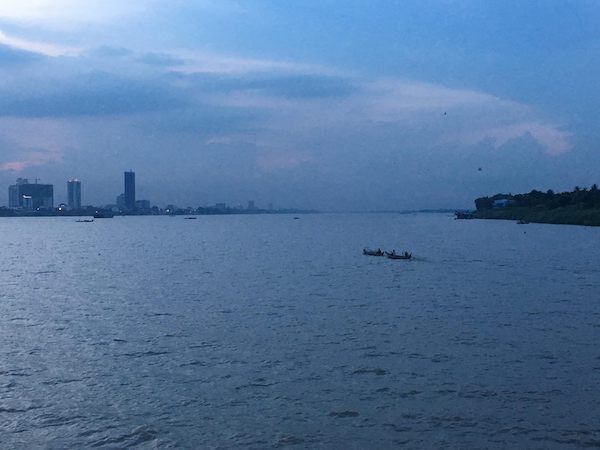
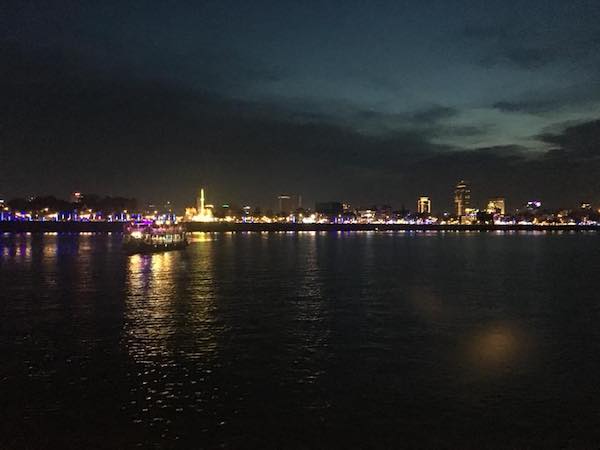
On Friday, we went to Mondulkiri, a northeast province of Cambodia bordering Vietnam, known for its cooler temperatures and lush forests. We took a minivan, one of the more affordable ways of getting around the country (about $25 roundtrip) with a six-hour drive-time. Upon arrival at the bus station, we learned that our bus was overbooked, with thirteen people for twelve seats. In keeping with my usual luck, it was my seat that had been double booked. Our party of eight decided we would rather cram together than send myself (or Lennart, the other person that had purchased Seat 6) on the midnight bus. Thus, we had a six-hour van ride where we all got to know each other very well, jammed like sardines into a car bumpier than most theme park rides (see: the Indiana Jones ride at Disneyland). At first, Lennart and I lightly complained to the bus company, getting a slight refund. In the end, however, you just have to accept that this is Cambodia and, more often than not, travel hiccups are par for the course.
Upon arrival in Sen Monorom, the primary village in Mondulkiri, we took a tuk tuk to our lodge, situated just five minutes outside of town. The road to the lodge was steep and unpaved, the tuk tuk driver navigating the path’s divots and corrugations with practiced ease. I gained tremendous respect for the Cambodian rickshaw, which off-roads remarkably well for something with only three wheels. While Sen Monorom’s center is well lit at night, it takes little time to ascend into the pitch-dark hills of Mondulkiri, our caravan of tuk tuks closely surrounded by the overlapping clicking of insects. Without incident, our gaggle of eight arrived at our lodge, exhausted from our day of traveling and eager to check out the accommodations.
We were not disappointed. Our eco-lodge was incredible. Nestled in the hills of Mondulkiri, we shared quaint bungalows in pairs, raised on stilts (the norm in Cambodia) with mosquito nets for each bed. Because of the slightly higher altitude, we did not need air conditioning- or even fans. The lodge also had a lovely common area, more of an open-air treehouse than a traditional hotel lobby. For the rest of the evening, that became our stomping ground, enjoying wifi and dinner. Since it is currently the rainy season in Cambodia, tourism is low (and hotel prices are prime!). As such, we were the only guests at the lodge, which I imagine is in high demand during the winter months. Because I had personally booked the lodge for our party of ten (two arrived later on the night bus), I served as our group's unofficial representative to the staff, spending a few minutes each day talking to the them about the lodge’s future developments.
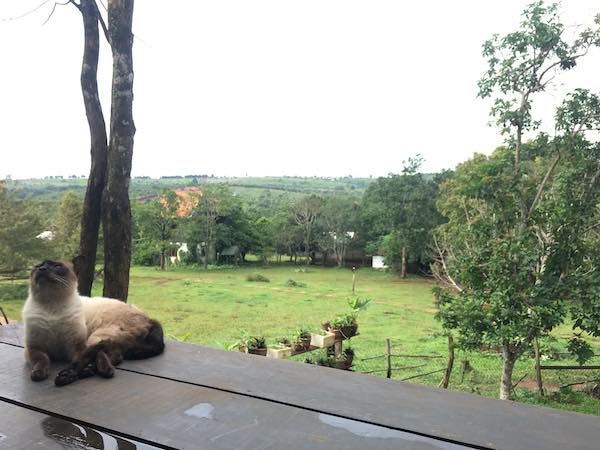
On Saturday morning, we were picked up for our elephant sanctuary tour. I was awake first, downing my iced Americano coffee in relaxing solitude. In the daylight, I realized how beautiful Mondulkiri was, but not in the way I expected. The region is rather mountainous, with sparsely treed hilltops and lushly forested lowlands. I was continuously struck by the beauty of the bright emerald countryside, streaked with paths of sharply contrasting red clay.
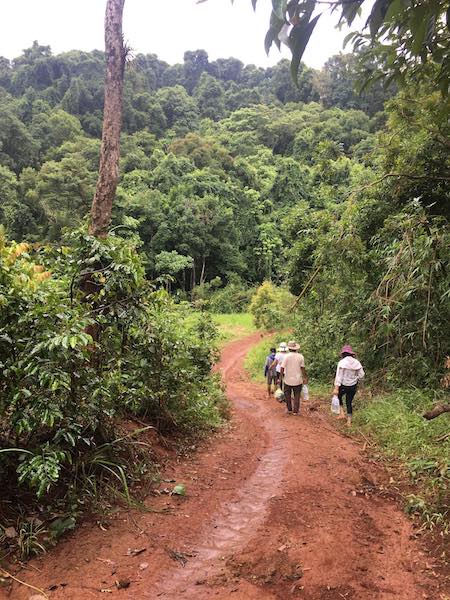
For both good and bad reasons, our elephant sanctuary tour was unforgettable. On the one hand, the trip was incredible. We were introduced to three elephants total, each magnificent and gentle. Since they were “village elephants,” raised by the aboriginal Bunong people, they were docile and trained to work. On our tour, we were able to pet the elephants, feed them bananas, and even bathe them in a nearby stream. It was, for lack of a better word, magical. I had never been so close to Asian elephants, not to mention in their natural habitat.


However, our group rapidly became aware of the problematic aspects of our trip. Advertised as an idyllic sanctuary, we realized increasingly that the elephants, about five in total, were effectively rented by the “sanctuary” from the Bunong for profit. About every hour of our trip, our guide would let slip something deeply troubling about the elephants’ care, filling in a piece of a depressing puzzle that was hard to ignore. This was particularly frustrating for our group, because we had paid for this tour with the understanding that it was ethical. After the tour ended, I went online to check if there were any warning signs that the sanctuary was actually a thinly-veiled elephant petting zoo. Ultimately, there were none.
It’s not all gloom, however. I did really enjoy our day, elephants included. That said, we had the most fun during our afternoon swim. When we arrived at the river pool, situated next to a small waterfall, several of us (myself included) balked. The water was an opaque muddy brown; additionally, we all had some extremely valid fears involving leeches. However, with intrepid spirit, we waded into the cool waters, laughing at our evident lack of self-preservation. The current from the waterfall was strong and, several times, my feet couldn’t touch the bottom of the pool. Even as an experienced swimmer, I felt myself overwhelmed by the flow, pulled under the surface several times. Eventually, however, we began working together to find good underwater boulders and logs on which we could cling or stand. Behind the waterfall was a small spot you could sit and look out through the sheets of water. While not what I expected, our group managed to make our own fun, which is often the best kind.

After splashing around for a half hour, a Bunong person arrived, perched atop his elephant. Both descended slowly into the river and we were invited to help bathe the elephant. As a very short person, I admittedly mostly clung to the elephant as I treaded in the deep water, doing my best to stay afloat. While the spectacle was troubling for the reasons I mentioned earlier, I could not ignore that this was an astonishing experience, beyond description. There was just something unspeakably powerful about being in the water with the elephant, a waterfall rushing in the background, vibrant green foliage framing my view. After a few minutes of being rendered speechless by the encounter, most everyone exited the water, sensing that we were crowding and stressing the elephant. Afterwards, I felt bad about having taken part, though I still remained in a state of silent awe.
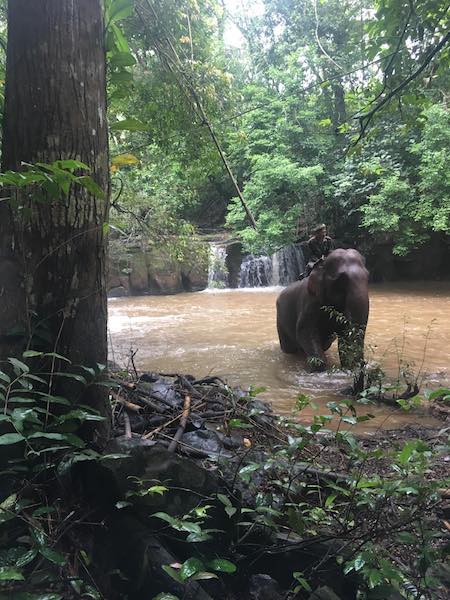
At the end of the tour, we were crowded into the back of pick-up truck designed to haul pigs. In classic fashion, the sanctuary tour had failed to book enough minivans for our group, so we all had to stand in the back of the truck. At first, I was pretty frustrated and concerned about safety. After all, on the average Cambodian road, aggressive driving and speeding is standard. After a few minutes of driving, however, I relaxed. This is Cambodia. You just have to role with the punches. Plus, the view of Mondulkiri, coupled with the rush of cool forest air, was spectacular. While I consider myself to be a seasoned traveler, I have a lot to learn about the customs of Southeast Asia. Ultimately, I have discovered that a relaxed disposition will carry you farther than anything else..
Arriving back in Sen Monorom, we disembarked from our pig pen shuttle and walked through the market briefly. Markets in Cambodia generally feel very similar. This one, however, was much more provincial than any market in Phnom Penh (which makes sense). The main road was entirely red clay, with children playing in muddy puddles in the alleyways. Jean and I admired knock-off Gucci jumpsuits before our group hustled off to a cafe for dinner.

The cafe we selected trains Bunong people to work in the restaurant industry. It was a lovely little place, our massive group taking up several tables. They also sold Bunong crafts, so I bought my very first souvenir from Cambodia: a colorful, handwoven scarf. After working up some joint courage between myself and my new French friend, Benjamin, we decided to try the one traditional Cambodian dish I swore was beyond me: fertilized duck egg. Suffice to say, I ate it. Honestly, it was not so bad thanks to Vin’s advice. She showed me the best way to dress the dish by dipping the egg in Kampot pepper and covering each bite with leaves (ostensibly so you cannot see what you are about to put in your mouth). While, fertilized duck egg is not going on my short-list of favorite Cambodian snacks, I am proud I tried it! My bucket list gets shorter every day.
In the evening, our group’s revelry built. Back at the lodge, we had a great time playing various dice games, pool, and so on. Since we were effectively the only lodge guests, we had run of the treehouse. As we chatted amongst ourselves, the noisy din from tree frogs and crickets threatened to drown out our music. Bats fluttered into the room, snatching mosquitos before flying back outside in the blink of an eye. At one point, a massive beetle crawled across the pool table, garnering my undivided attention for several minutes. I realized how lucky I was to be in such a wild, beautiful place, surrounded by such fun people that shared my enthusiasm. Our group ran the gamut: American, German, French, Belarusian, Khmer. Truly, we all had such a great time as newfound friends, watching geckos skitter along the walls, telling fun stories from our vastly different lives.

On Sunday morning, I awoke early to the mellow sound of rain on the roof of my bungalow. Sleepily, I made my way to the lodge common area and had my iced coffee, awaiting the rest of my friends. Goka, the lodge’s fifteen-year-old Siamese cat, settled comfortably into my lap as I laid in a hammock, watching the hazy drizzle outside. Eventually, our group materialized and made our way to a Mondulkiri coffee plantation. After having a cup of famous Mondulkiri coffee, we roamed the grounds, checking out the plentiful avocado trees and nascent pineapple plants. Eventually, our low-key morning was over and it was time to catch the bus back to Phnom Penh.
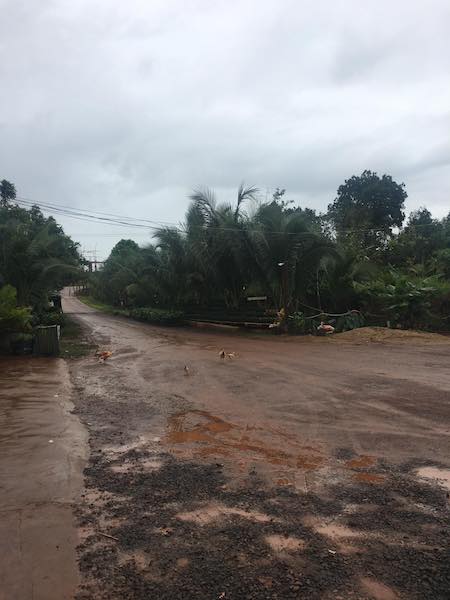
I mentioned earlier that it rained for most of our weekend in Mondulkiri. While not an issue, my feet were stained bright red from the clay, my shoes a grimy maroon mess beyond repair. Additionally, on the drive back, nearly every road was paved except one brief stretch of road to Phnom Penh that was dirt. Our bus literally could not maintain traction on the wet clay, slipping and skidding downhill. Our driver, who was luckily very talented, glided us through traffic, narrowly dodging cars slipping in the opposite direction. While initially very funny, at one point I had to lean back in my bus seat and just breathe.
On Monday, we said goodbye to Lennart. While we have been saying goodbye to Lennart for over two weeks (somehow), finally it was real. His internship at ODC was officially over and now he was going to travel around Southeast Asia for a bit. Our Mondulkiri group, plus a few more, enjoyed some western food in the Russian Market area, ending the night with some lively games of darts and bocce ball (there really is something for anyone in Phnom Penh!). The night ended with me deciding to buy Lennart’s old bicycle that he was leaving behind. I am pretty excited to have a bike, which I think will give me a bit more freedom to roam the city.
This weekend, Jean and I are going to Cambodia’s southern islands, specifically Koh Rong Sanloem. The island is supposed to be beautiful, relatively untouched, and outfitted with stunning white sand beaches. Most excitingly, Sanloem is apparently one of the best places to see glowing plankton at night. After my raucous weekend in Mondulkiri, I’m looking forward to a sedate beach trip.